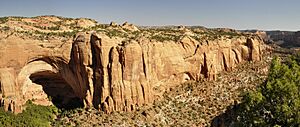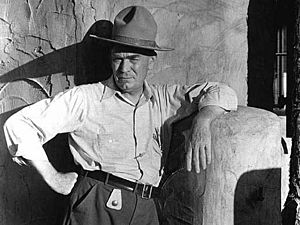National monument (United States) facts for kids
In the United States, a national monument is a special protected area. It can be created from land owned by the U.S. government. Either the President of the United States can declare it, or Congress can pass a law to make it one.
National monuments protect many different things. These include important natural places, ocean areas, old archaeological sites, and places important to history or culture.
There are 129 national monuments in the U.S. Different government groups look after them. These include the National Park Service, the United States Forest Service, and the United States Fish and Wildlife Service. Some are also managed by the Bureau of Land Management and the National Oceanic and Atmospheric Administration.
The Antiquities Act of 1906 gives presidents the power to create national monuments. President Theodore Roosevelt used this law to declare Devils Tower in Wyoming as the very first U.S. national monument.
Contents
How National Monuments Started
The Antiquities Act was created in 1906. People were worried about protecting old Native American ruins and artifacts in the western U.S. The law made it illegal to take or destroy these old items without permission. It also allowed the president to protect "historic landmarks" and "objects of historic or scientific interest" on federal lands. The protected area had to be the smallest size needed to care for the objects.
Presidents have used this law to create new national monuments. They have also made existing ones bigger. For example, President Franklin D. Roosevelt made Dinosaur National Monument much larger in 1938. President Lyndon B. Johnson added Ellis Island to the Statue of Liberty National Monument in 1965. In 1978, President Jimmy Carter greatly expanded Glacier Bay and Katmai National Monuments.
Early Monuments and Big Ideas
When the Antiquities Act was written, it mentioned "objects of ... scientific interest." This allowed President Theodore Roosevelt to protect natural places. Just three months after the law passed, he made Devils Tower in Wyoming the first national monument. It's a unique geological rock formation. Later that year, he also protected Petrified Forest in Arizona, another natural wonder.
In 1908, Roosevelt used the law to protect a huge area of the Grand Canyon. This was over 800,000 acres (3,200 km²). Some people thought he protected too much land. A mining company even sued, saying he went too far. But in 1920, the U.S. Supreme Court agreed that the Grand Canyon was "an object of historic or scientific interest." They said it could be protected by the president. This decision set a rule that presidents could use the Antiquities Act to protect large areas.
Mid-Century Changes
In 1918, President Woodrow Wilson created Katmai National Monument in Alaska. It was over 1 million acres (4,000 km²). Later, it grew even larger. For many years, it was the biggest national park system area.
Some national parks, like Petrified Forest, Grand Canyon, and Great Sand Dunes, actually started as national monuments. Later, Congress changed them into national parks.
In 1943, President Franklin D. Roosevelt used the act to create Jackson Hole National Monument in Wyoming. He did this to accept land donated by John D. Rockefeller Jr.. Congress had not agreed to add this land to Grand Teton National Park. Many people were upset, saying the president was going around Congress. A bill to get rid of Jackson Hole National Monument passed Congress, but Roosevelt stopped it. In 1950, most of the monument became part of Grand Teton National Park. However, a new rule was made that limited how presidents could use the act in Wyoming.
Recent National Monuments
A very big use of the Antiquities Act happened in 1978. President Jimmy Carter created 17 new national monuments in Alaska. He did this after Congress failed to pass a large bill about Alaska's lands. In 1980, Congress passed a new version of the bill. It turned most of these monuments into national parks or preserves. The act also limited how presidents could use the Antiquities Act in Alaska in the future.
President Carter's 1978 monuments included Misty Fjords and Admiralty Island. These were the first monuments managed by the U.S. Forest Service. Others, like Becharof and Yukon Flats, were managed by the Fish and Wildlife Service. These later became national wildlife refuges.
The act wasn't used again until 1996. President Bill Clinton then created the Grand Staircase–Escalante National Monument in Utah. This was the first national monument managed by the Bureau of Land Management. Many people in Utah were not happy about this. Most of the 16 national monuments created by President Clinton are managed by the Bureau of Land Management, not the National Park Service.
President George W. Bush created four large marine (ocean) national monuments in the Pacific Ocean. These are managed by the Fish and Wildlife Service, with the National Oceanic and Atmospheric Administration helping with ocean life. President Barack Obama made two of them much bigger and added a fifth one in the Atlantic Ocean.
On June 24, 2016, President Barack Obama named the Stonewall Inn and nearby areas in Greenwich Village, New York, as the Stonewall National Monument. This was the first national monument to remember the fight for LGBT rights in the U.S. He also created others that recognized civil rights history, like César E. Chávez, Belmont–Paul Women's Equality, and Freedom Riders National Monuments.
In December 2017, President Donald Trump made Bears Ears and Grand Staircase–Escalante National Monuments much smaller. This removed protection from about 2.8 million acres of land. This meant mining could start again in those areas. There are lawsuits challenging this decision. President Joe Biden has said he plans to reverse these changes.
List of National Monuments
See also
 In Spanish: Monumento nacional (Estados Unidos) para niños
In Spanish: Monumento nacional (Estados Unidos) para niños






